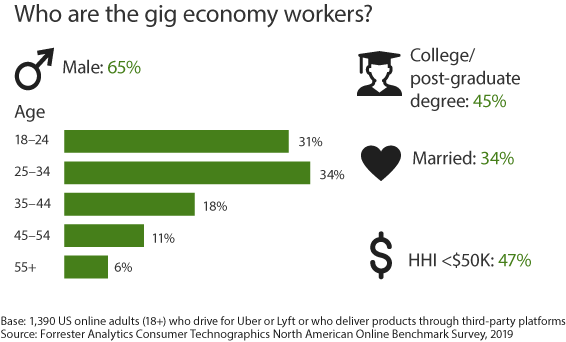No Matter How Their Drivers Are Classified, Uber And Lyft Must Commit To Better Work Experience
A recent bill signed by California Governor Gavin Newsom pressures ride-hailing companies like Uber and Lyft to label drivers as employees rather than independent contractors, with the intention of raising wages and giving access to workplace benefits. Uber and Lyft are resisting, as business leaders say they will not plan to reclassify drivers and employees and instead intend to celebrate independent work. Some ride-hailing drivers, eager to safeguard the flexibility and agency of the apps, do oppose the label of “employee.” Uber and Lyft are notorious for their poor employee experience, however; drivers frequently rise in protest over unfair treatment like freezing drivers out of apps to save on costs when there is a lull in demand.
The battle between companies and courts on this issue is just the beginning of what’s to come. As technology accelerates the size and speed of the gig economy’s growth, leaders, employees, and consumers will grapple with fitting the gig culture into familiar frameworks that steer business decisions.
What should Uber and Lyft (and others capitalizing on the gig culture) do?
It starts with empowering their workers — employees, contractors, or otherwise — by:
- Stopping the use of dark patterns. Our research shows that employee experience is a prerequisite to business success. One of the most important factors in a good employee experience is the “freedom to decide how best to do their job.” In theory, independent contractors have that freedom — but Uber and Lyft undermine it by using dark patterns that hack human behavior for ill. For example, both companies send drivers their next fare before the previous one is finished. This type of queuing encourages binge-driving, just like Netflix loading the next episode of a show encourages binge-watching. Drivers are less likely to take breaks and find it harder to affirmatively decide whether or not to take the next fare. Uber and Lyft should commit to responsible use of behavioral sciences that nudge workers to make decisions that improve their experience and well-being.
- Helping independent workers feel a sense of belonging. Forrester Analytics’ Consumer Technographics® data reveals that both gig economy workers and consumers value the convenience and flexibility inherent in the service model. However, gig economy workers are nearly twice as likely as the average US online adult to value the sense of community. Classification of Uber and Lyft workers as “employees” or “contractors” must not distract from the reality that they are human beings who want to be part of something meaningful. Corporations increasingly feel pressure to deliver on emotional needs of all of their stakeholders; Uber and Lyft will fall out of step if they don’t do the same.
- Aligning company and employee values. According to our data, the companies that enable employees to live the values that workers care about position themselves for long-term success. Eight in 10 such firms offer a top-tier customer experience and four in 10 report double digital revenue growth, compared to only 65% and 32%, respectively, of firms on average. Uber and Lyft should be more explicit about articulating their values, and they must make it clear how their drivers contribute to delivering that value. As both ride-share companies have invested heavily in autonomous vehicle technology, drivers are right to believe that they’re not a long-term part of the ride-share value equation.

Connect with Sam Stern to learn more about the employee experience and the future of work and Anjali Lai to learn more about how company values and emerging technology influence behavior and attitude.
